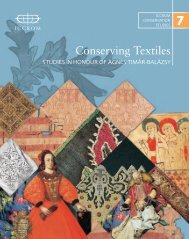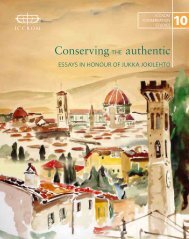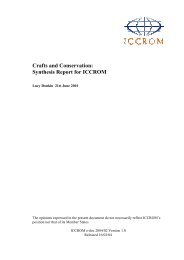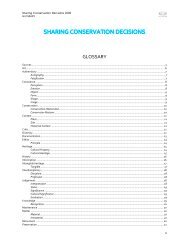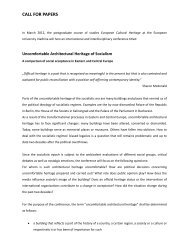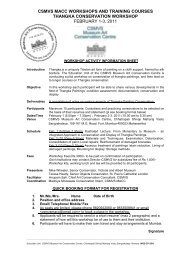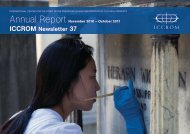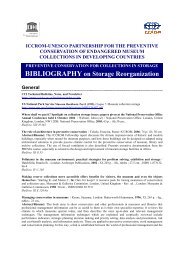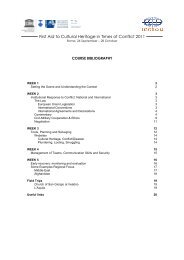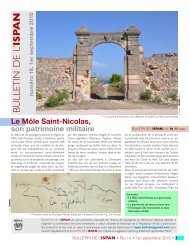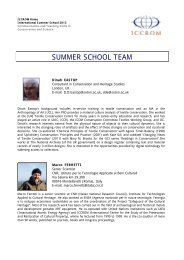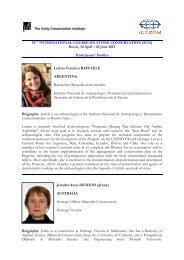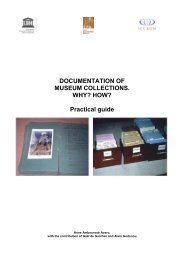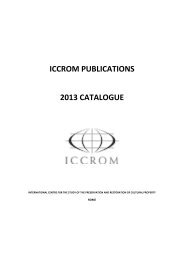part 1 - Iccrom
part 1 - Iccrom
part 1 - Iccrom
Create successful ePaper yourself
Turn your PDF publications into a flip-book with our unique Google optimized e-Paper software.
MEASURING HERITAGE CONSERVATION PERFORMANCE<br />
6th International Seminar on Urban Conservation<br />
Based upon this research, we expect that in the<br />
future it will become possible to draw conclusions<br />
on how heritage policies and management could<br />
better and more efficiently deal with this problem<br />
in order to meet the evolving needs of the local community<br />
as well as to avoid adversely impacting the<br />
OUV; in other words, to develop sustainably.<br />
References<br />
Figure 4. Closed veranda in Galle Fort (Boxem and<br />
Fuhren, December 2010).<br />
From the first exploratory oral inventories with<br />
employees of the De<strong>part</strong>ment of Archaeology<br />
(DA) and the Galle Heritage Foundation (GHF),<br />
stakeholders concerned with the policy and management<br />
regarding developments within the fort,<br />
preliminary conclusions can be drawn that many of<br />
the verandas have been purposely shut by the private<br />
owners, in order to meet their social need of<br />
increased privacy (ibid.), Figure 4.<br />
Besides that, the Periodic Report of 2003 by the<br />
State Party of Sri Lanka states as well that “an<br />
increase of unauthorized changes either in use or<br />
in its architectural appearance, [have been] altering<br />
the street-scapes within the Fort” (UNESCO and SP,<br />
2003). This could very well be a reference to verandas,<br />
although it is not made specific.<br />
Following further inventories, conclusions can be<br />
drawn on the authenticity and integrity of the ‘open<br />
verandas supported by columns’ in 2011. While this<br />
is still a work in progress, the preliminary statement<br />
that these unauthorized changes, the shutting of the<br />
verandas, have resulted in a decrease in authenticity<br />
and integrity of the attribute, negatively affecting<br />
the ‘aesthetic value’ and thus, the OUV of the<br />
historic centre of Galle.<br />
Since this is still work in progress, next steps are<br />
to find out whether there are additional reasons for<br />
private owners to close the veranda of their houses<br />
beyond the social need for more privacy. Also, we<br />
will examine whether stakeholders concerned with<br />
the policy and management regarding developments<br />
within the fort recognize this development as<br />
a threat to the OUV of Galle Fort and whether they<br />
have s sufficient and adequate regulations to stop<br />
those unauthorized changes.<br />
ICCROM, ICOMOS, IUCN and UNESCO. 2010.<br />
Guidance on the preparation of retrospective statements<br />
of outstanding universal value for World Heritage<br />
Properties. (Available at: http: //cmsdata.iucn.org/<br />
downloads/whouven.pdf).<br />
ICOMOS Sri Lanka. 1988. Advisory Body<br />
Evaluation. (Available at: http: //whc.unesco.org/<br />
archive/advisory_body_evaluation).<br />
Kuruppu, I. & W. Gamini. 1992. The conservation<br />
of the Galle Fort and its environs: a special volume<br />
to mark the occasion of the completion of the phase<br />
one of the long term preservation programme for the<br />
World Heritage City of Galle. Number 15 of Ancient<br />
Ceylon. Sri Lanka, Puravidya De<strong>part</strong>amentuva.<br />
Lewcock, R.B., Sansoni, B. Laki, & C. Anjalendran.<br />
1998. The architecture of an island. The living legacy of<br />
Sri Lanka : a thousand years of architecture illustrated<br />
by outstanding examples of religious, public, and<br />
domestic buildings. Colombo, Barefoot Ltd.<br />
Pereira Roders, A. 2007. Re-architecture: lifespan<br />
rehabilitation of built heritage. Eindhoven: Eindhoven<br />
University of Technology. (PhD Thesis).<br />
Pereira Roders, A., Veldpaus, L. and B.<br />
Colenbrander. 2010. Cultural Heritage and<br />
Sustainability: World Heritage cities as case study.<br />
Pereira Roders, A. & R. Van Oers, 2010.<br />
Outstanding Universal Value, World Heritage Cities<br />
and Sustainability.<br />
UNESCO. 2008. Operational Guidelines for the<br />
Implementation of the World Heritage. World Heritage<br />
Centre.<br />
UNESCO. World Heritage Centre. (Available at:<br />
http: //whc.unesco.org/en/criteria).<br />
UNESCO & State Party of Sri Lanka (SP). 2003.<br />
Periodic Report by State Party. UDA State Party of Sri<br />
Lanka. 2003. Nomination file.<br />
Boxem, R.; Fuhren, R.; Pereira Roders, A.; Veldpaus, L.·& B. Colenbrander. 2012. Assessing the cultural significance of World Heritage<br />
cities: the historic centre of Galle as a case study. In Zancheti, S. M. & K. Similä, eds. Measuring heritage conservation performance, pp.<br />
75-81. Rome, ICCROM.<br />
81



